
Measuring Charging Voltage and Current
To check the charger is working, follow these steps then consult the expected conditions listed below.
1.VOLTAGE – Place voltmeter across battery terminals (“V” in diagram).
2.CURRENT – Turn off AC power supply before breaking into the line to measure DC Amps. Break the positive line to the battery and place an ammeter between positive from charger and positive of battery (“A” in diagram).
Current Flow from Charger to Battery
If voltage at terminals is less than nominal battery voltage then the maximum rated charger current should be present.
NOTE: Once battery is fully charged, output current should be between 0.1% and 0.5% of batteries AH capacity plus any standing loads.
Voltage Rise at Battery Terminals
A gradual rise of voltage should be seen showing as float voltage is reached – batteries should not be boost charged continuously.
NOTE: If the battery voltage increases rapidly during charge and no minimum current is measured then the battery may have become sulphated and will not hold charge and may be unrecoverable.
Output Voltage
LEAD |
| 12/v | 24/v | |
Float: | 13.6V | 24.2 | ||
ACID | ||||
Boost: | 14.1 | 28.2V | ||
|
Typical output with no battery or load connected. For all Guardian models the precalibrated float voltage should be present.
Section 75 | |
- 11 - |
